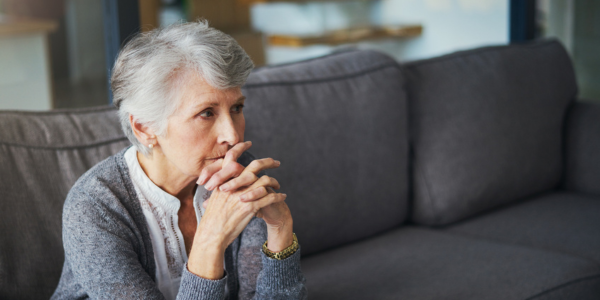
September is National Suicide Awareness and Prevention Month, a time to examine and break down the stigma around depression and suicide, as well as educate ourselves on how to better support loved ones who face these common but serious illnesses.While people of any age can struggle with suicidal thoughts and actions, seniors are increasingly at risk.According to the National Council on Aging (NCOA), older adults accounted for 16.8% of the U.S.population but 22% of suicides in 2022.
Additionally, research found that seniors tend to plan more carefully and choose more lethal methods.Per NCOA, among people who attempt suicide, one in four older adults will succeed, compared to 1 in 200 youths.Suicide attempts that fail are also more likely to cause severe harm to older adults, as they may have a harder time recovering than a younger person due to underlying health issues and increased frailty.It is important to remember that depression, while a common medical condition, is not a normal part of the aging process.
Symptoms, such as a feeling of emptiness or a lack of interest in previously enjoyable activities, should be taken seriously.Not every person who experiences depression will also experience thoughts of suicide.However, depression left untreated can worsen over time.Older adults face an assortment of risk factors that put them at higher risk of depression and suicide.
One of the most widespread risk factors is loneliness.Some mental health experts assert that there is currently a loneliness epidemic and seniors are no exception.Being homebound, losing a spouse or other close loved ones, and lacking or being cut off from a social circle are all very real problems that can worsen feelings of loneliness for older adults.In addition to loneliness, many seniors experience grief over lost loved ones, loss of self-sufficiency, major changes in their lives, and more.
Chronic illness and pain can also limit seniors abilities to do what they used to, which might further compound already existing loneliness or grief.Financial troubles and insurance barriers, such as providers opting out of billing Medicare, can prevent older loved ones from efficiently caring for their physical, emotional, and mental health.This can worsen previously existing mental illnesses like clinical depression and certain cognitive conditions like dementia, both of which can further increase seniors risk of suicide.While seniors may be reluctant to open up about how they feel, there are suicide warning signs that you can look for.Learning to spot these signs will go a long way in helping you properly support your loved one.
Symptoms will look different for each person, but common signs include:Giving away beloved itemsSuddenly putting their affairs in orderMaking changes to their willAvoiding social activitiesNeglecting self-care and personal groomingBreaking medical regiments, such as ignoring their diets or not taking prescriptionsFeelings of hopelessness, worthlessness, guilt, and/or emptinessLack of concern for personal safetyExhibiting a preoccupation with death and obtaining lethal means, such as stockpiling medicineRemarks such as This is the last time youll see me or I wont be needing any more appointments.Although all these signs should be taken seriously, the most critical indication of suicide risk is an explicit expression of suicidal intent.The topic of suicide is serious and can be frightening or uncomfortable for people.However, having the right tools to navigate this discussion can help you feel properly equipped to care for and support your loved ones.If you know a senior who is at risk of suicide or showing warning signs, the national 988 Suicide and Crisis Lifeline has put together five action steps that you can take.Ask.Be There.Keep Them Safe.Help Them Connect.Follow Up.There is a common myth that talking about suicide increases suicide or suicidal thoughts.
However, research indicates that this is not the case, and, in fact, the opposite may be true.Asking direct questions such as Are you thinking about suicide? can communicate that you are able to have a non-judgmental, supportive, and open conversation.Questions such as Have you made a plan? and How do you hurt? are other good ones to ask.
Remember to also ask questions like How can I help you? and, most importantly, to listen carefully in an understanding and unbiased way.Be there for your loved one by being physically present if possible or connecting with them via phone or video calls if not.Collaborate with the person to identify other safe and trusted individuals who may be willing to help, especially if you are unable to physically be there for them.
If your loved one is in a senior living community, consider what resources may be available to help your loved one stay connected and safe.Inquire about additional staffing options, routine changes, or implementing additional safety checks.Ask questions to learn whether the person has a specific plan or timing in mind, whether they have access to a method of self-harm, and whether they have attempted to end their life before.
These answers will help you determine whether they are in immediate danger.In general, the more detailed their plan is, the higher the risk.Remember that its okay to know your limits and lean on external resources.
If your senior loved one is at imminent risk of harm, more intensive intervention such as calling 911 or contacting 988 may be needed.If they are not at immediate risk, take steps to help them connect with a support system they can rely on.This support system can and should include both formal resources like suicide prevention helplines, mental health counselors, and local resources in their community, and informal resources, including a strong social circle of friends and family.Seniors experiencing social isolation or worsening depression may find renewed strength in a community setting.
A senior living community can provide a vital social support network for seniors and their families and can connect older adults to essential social interaction, daily assistance, 24/7 safety and security, and access to professional expertise from a team of certified nursing and wellness professionals.Perhaps the most crucial step is the final one in the action plan: following up.Make sure you do not just have one initial conversation with your loved one at risk and then ignore the topic afterward.
You dont need to push or pry, but something as simple as a quick call to check in will make a significant difference.Research hasshown that the act of following up can reduce suicide-related deaths in populations that are at elevated risk.Seeing your senior loved one showing symptoms of suicidal thoughts or intent can be an upsetting experience.But remember that knowledge is power, and your support is meaningful.
Take these symptoms seriously and take action to care for your aging loved one and connect them to life-saving resources.If your senior loved one is experiencing feelings of depression, loneliness, apathy, and isolation, talk to their physician about the benefits of a senior living community.Learn more about how a UMH senior living community can serve and support the physical, emotional, spiritual, and mental health needs of older adults who are aging by subscribing to our blog for additional resources.For caregivers in need of support, or seniors looking for vital social connections, reach out to a member of our team who is ready and able to help.To find out how United Methodist Homes provides a wealth of offerings and opportunities to support the health and well-being of our residents, contact us today or schedule a complimentary visit now.
Publisher: Assisted & Independent ( Read More )

